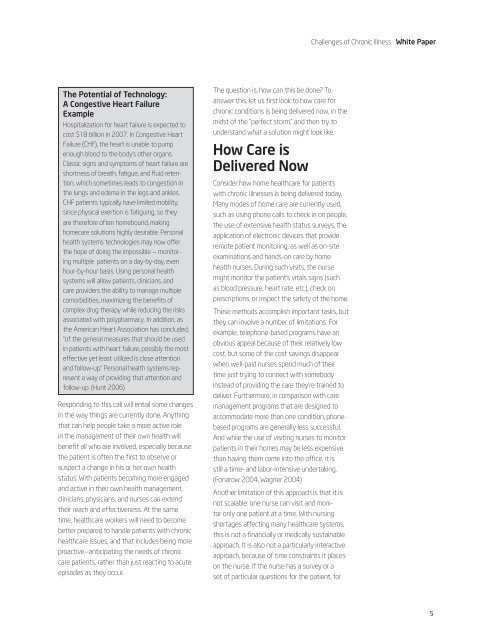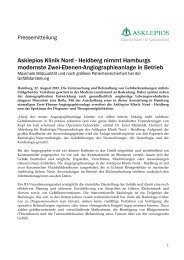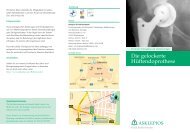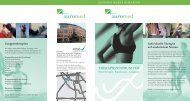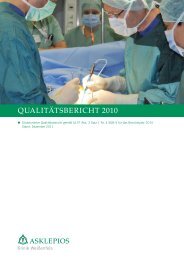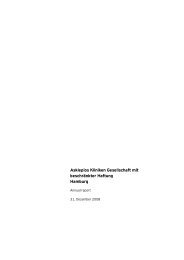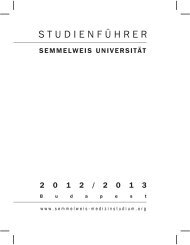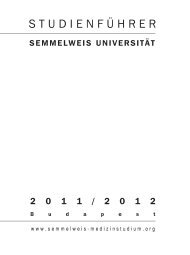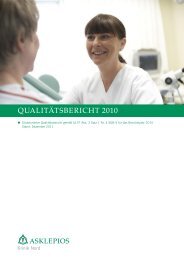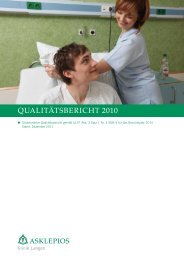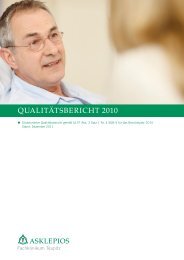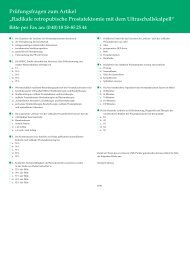Download Sammelmappe - Asklepios
Download Sammelmappe - Asklepios
Download Sammelmappe - Asklepios
Erfolgreiche ePaper selbst erstellen
Machen Sie aus Ihren PDF Publikationen ein blätterbares Flipbook mit unserer einzigartigen Google optimierten e-Paper Software.
The Potential of Technology:<br />
A Congestive Heart Failure<br />
Example<br />
Hospitalization for heart failure is expected to<br />
cost $18 billion in 2007. In Congestive Heart<br />
Failure (CHF), the heart is unable to pump<br />
enough blood to the body’s other organs.<br />
Classic signs and symptoms of heart failure are<br />
shortness of breath, fatigue, and fluid retention,<br />
which sometimes leads to congestion in<br />
the lungs and edema in the legs and ankles.<br />
CHF patients typically have limited mobility,<br />
since physical exertion is fatiguing, so they<br />
are therefore often homebound, making<br />
homecare solutions highly desirable. Personal<br />
health systems technologies may now offer<br />
the hope of doing the impossible — monitoring<br />
multiple patients on a day-by-day, even<br />
hour-by-hour basis. Using personal health<br />
systems will allow patients, clinicians, and<br />
care providers the ability to manage multiple<br />
comorbidities, maximizing the benefits of<br />
complex drug therapy while reducing the risks<br />
associated with polypharmacy. In addition, as<br />
the American Heart Association has concluded,<br />
“of the general measures that should be used<br />
in patients with heart failure, possibly the most<br />
effective yet least utilized is close attention<br />
and follow-up.” Personal health systems represent<br />
a way of providing that attention and<br />
follow-up. (Hunt 2006)<br />
Responding to this call will entail some changes<br />
in the way things are currently done. Anything<br />
that can help people take a more active role<br />
in the management of their own health will<br />
benefit all who are involved, especially because<br />
the patient is often the first to observe or<br />
suspect a change in his or her own health<br />
status. With patients becoming more engaged<br />
and active in their own health management,<br />
clinicians, physicians, and nurses can extend<br />
their reach and effectiveness. At the same<br />
time, healthcare workers will need to become<br />
better prepared to handle patients with chronic<br />
healthcare issues, and that includes being more<br />
proactive—anticipating the needs of chronic<br />
care patients, rather than just reacting to acute<br />
episodes as they occur.<br />
The question is, how can this be done? To<br />
answer this, let us first look to how care for<br />
chronic conditions is being delivered now, in the<br />
midst of the “perfect storm,” and then try to<br />
understand what a solution might look like.<br />
How Care is<br />
Delivered Now<br />
Consider how home healthcare for patients<br />
with chronic illnesses is being delivered today.<br />
Many modes of home care are currently used,<br />
such as using phone calls to check in on people,<br />
the use of extensive health status surveys, the<br />
application of electronic devices that provide<br />
remote patient monitoring, as well as on-site<br />
examinations and hands-on care by home<br />
health nurses. During such visits, the nurse<br />
might monitor the patient’s vitals signs (such<br />
as blood pressure, heart rate, etc.), check on<br />
prescriptions, or inspect the safety of the home.<br />
These methods accomplish important tasks, but<br />
they can involve a number of limitations. For<br />
example, telephone-based programs have an<br />
obvious appeal because of their relatively low<br />
cost, but some of the cost savings disappear<br />
when well-paid nurses spend much of their<br />
time just trying to connect with somebody<br />
instead of providing the care they’re trained to<br />
deliver. Furthermore, in comparison with care<br />
management programs that are designed to<br />
accommodate more than one condition, phonebased<br />
programs are generally less successful.<br />
And while the use of visiting nurses to monitor<br />
patients in their homes may be less expensive<br />
than having them come into the office, it is<br />
still a time- and labor-intensive undertaking.<br />
(Fonarow 2004, Wagner 2004)<br />
Another limitation of this approach is that it is<br />
not scalable: one nurse can visit and monitor<br />
only one patient at a time. With nursing<br />
shortages affecting many healthcare systems,<br />
this is not a financially or medically sustainable<br />
approach. It is also not a particularly interactive<br />
approach, because of time constraints it places<br />
on the nurse. If the nurse has a survey or a<br />
set of particular questions for the patient, for<br />
Challenges of Chronic Illness White Paper<br />
5


